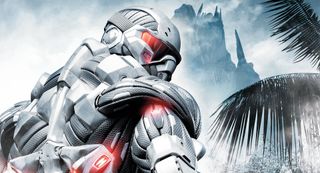
Article by GB Burford
When developer Crytek launched Crysis in 2007, the entire gaming world let out a collective gasp. How could a game look this good, much less bring Nvidia’s legendary 8800 to its knees? The running joke for computing hardware became “sure, it’s powerful, but can it run Crysis?” So how is it that when Crysis 2 and 3 came along, they were considered disappointments to the series? How exactly can anyone make a disappointing sequel to a game widely recognized as a mere tech demo?
It’s because “tech demo” was never an adequate descriptor. You see, Crysis wasn’t just a pretty face, it also happened to be one of the best first-person shooters ever made. A good shooter emphasizes player freedom and creativity, and Crytek more than delivered, adding its own AI, a broad implementation of physics that has yet to be matched, and gigantic maps to the foundation of classic PC shooters. The sequels, unfortunately, abandoned most of these ideas, still delivering large maps and great graphics, but little else.
To understand what made Crysis so great (and where the sequels lost their way), let’s look at its second level, "Recovery."
More than just a pretty face

The premise Crysis opens with is simple: some North Koreans captured an island they shouldn’t have, and you’re part of an elite military force of dudes in super suits sent in to solve the situation. Problem is, something’s hunting both sides down. It’s more or less Predator.
"Recovery" begins with a quick cutscene that sets up the level: you’ll need to get to a small outpost and find out what’s going on. A quick jog later and you find a base that’s been attacked by whatever took your friend. In a way, it’s a playground—instead of simply dropping you into a big battle, Crysis provides a proverbial jungle gym for the player to hop around in. With guns.
You head down the road, where you’ll encounter your first living enemies. I decided to have some fun when I met ‘em. There I was, zipping up the coast in a North Korean humvee thing, when I spotted another one driving my way. I turned invisible, leaped out, and dove into the bushes as the two cars collided. The guards spilled out, shouting about how they were going to find and kill me, but I fired a few rounds off into the gas tank on the back of my humvee thing, which went up in a big boom, taking the other car—and the Koreans—with it. I didn’t just shoot at the car until it blew up; I had to specifically target the gas can on the back.
The biggest gaming news, reviews and hardware deals
Keep up to date with the most important stories and the best deals, as picked by the PC Gamer team.
Remember, this is 2007. The sandbox FPS is a rarity. Up to this point, the typical shooter, like Half-Life 2, drops you into a location to fight enemies who are already fully aware of your presence. Sure, how you weave around the map might change, as will the choice of guns you use, but Crysis gives you a whole lot more to play with.
Right off the bat, we can see how useful the suit is, especially because you can string its powers together in interesting ways. Try running at the humvee in maximum speed mode, then briefly switching to strength, jumping over it, landing, and then shooting the gas tank. You’ll dodge gunfire and cause a nice big explosion.
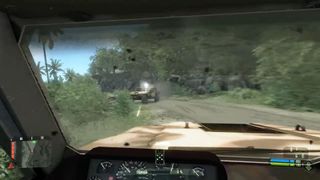
If you’re thinking that’s needlessly complex, you’re right. I could just switch to maximum strength to stabilize my specially-tailored rifle (built via the in-game customization system) and snipe them from afar. However you want to handle the situation, you can. I’ve never played Crysis the same way twice, and that’s by design: it’s one of the most dynamic video game experiences out there.
It’s also a great argument for quick saving; these days, in our console-dominated world, most shooters rely on simple checkpointing. The problem with checkpointing is that it needlessly limits your ability to experiment, which is important for a game like Crysis, where experimentation is half the fun. Being able to save at will and reload the same way empowers the player to push the game to its limits, enhancing their ability to enjoy it. Crysis is, in this way, a proper PC game. It celebrates the player’s options, even with something as basic as saving—something its sequels would forget.
Moving on, you’ll find yourself heading up a trail on a hill. A few guards are patrolling the forest here, but, again, the suit gives you plenty of ways to take them down. My initial attempts at mimicking Predator failed miserably, so I jumped behind a nice, thick tree, waited for my health to regenerate, and switched to my shotgun.
The soldiers had other ideas.
They shot the tree so much it fell over, leaving me exposed and taking damage. Panicked, I fired a shotgun blast directly into the chest of the nearest soldier, then quickly unloaded two rounds into the next guy. It’s at this point that I should praise Crysis’ shotgun. Too many console-centric games feature shotguns that don’t behave at all like the real thing--they’re often gimped with unrealistically short ranges for the sake of balance, as if single-player games need weak peashooters that aren’t fun to use. Crysis presents a shotgun that roars as it fires at enemies, tearing them to shreds as soon as they get within a dozen meters or so. I love it to pieces.
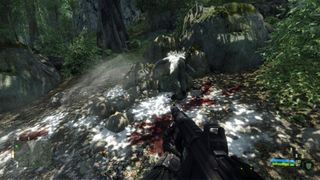
Classic shooters understood one simple rule: all guns should be overpowered, because overpowered guns are fun to shoot. Gimp a gun unnecessarily, and it’s no longer fun. Crysis, as a true PC shooter, is one of the few modern games that remembers to follow this rule. It’s a game that makes you feel like Predator, even when hiding behind trees ends up backfiring horribly.
Moving on, you’ll face a few more patrols, again given new and interesting ways to deal with them as changes to the terrain permit. I found myself hiding behind a much larger tree, leaning around it—because, oh yes, Crysis features lean—and sniping all who came my way. Shooters should all feature lean. The more tools in a player’s toolbox, the more flexible and varied the game can be; classic PC shooters understood that, and Crysis did too.
After that, you’ll come across a small outpost, which, again, you can tackle how you wish. I ended up blindly throwing a grenade, which blew up something that then set off a disastrous chain of explosions. I’m still not sure what I blew up, but by the time I entered the outpost, everyone was dead.
Another time, I simply went prone—Crysis features prone too—shot a guy, which lured his friends out to check on him, then shot them too. One guard got a bit too suspicious and started looking my way, so I shot something behind him. The guard turned to look, taking cover to be safe, which would have been smart had the cover been between us. Easy pickings.
The outpost is atop a hill. Down in the valley below is your objective, a base. The hill is a wonderful sniping position—and the outpost presents players with plenty of weapons, including a sniper rifle. Making your way down the hill can be tricky, because of a small enemy squad, but if you clear them out, you’ll find a wonderful spot on a rock about half-way down the hill, except for one problem.
There’s a tree in the way.
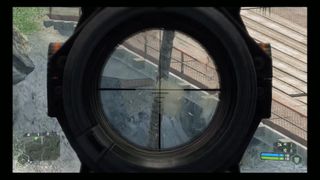
But Crysis already taught us how to deal with this: shoot the tree, it falls down. Prophet tells you that shooting the gas station will cause a distraction, and he’s right; it explodes in a giant fireball, providing you with a way to sneak in. Don’t feel like dodging mines or sneaking across a bridge? Feel free to take a hidden path around to the right of the base. Or consider a swim in the ocean and approaching the base from the opposite side!
Sneak—or fight—your way through town, reach the objective, watch the cutscene, and go fight some tanks. Up to this point, Crysis has had some intense gun battles. The enemies really react to getting shot, or having crabs thrown at them (yes, you can kill a man by throwing a crab at him). The tanks provide meaty targets, yet they’re not giant, aimless bullet sponges that take hours to kill. They’re highly mobile and deadly, but a single rocket launcher can easily take them out.
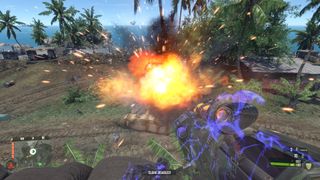
Escaping the village, you’ll head through a forest to meet Prophet, encountering several enemy patrols along the way. I hit one guy with a knockout dart, and he slipped into the river unconscious, which apparently drowned him. I choked another guy, using him as a meat-shield while his friends shot at me, until I got close enough to throw him so hard that the impact killed his friends. Can you think of another shooter that’s got this fidelity of detail? Soldiers who lose consciousness in water will drown; meat shields that take damage will die, but their bodies can still become deadly projectiles.
The level ends when you get to the other side of the forest.
This is Crysis in a nutshell; a game with a system of play predicated on player freedom and choice. The enemies are smart enough to be fun but not omnipotent, the guns feel meaty and overpowered, and most importantly of all, Crysis emphasizes player expression through its play.
Shooters are at their best when they’re varied experiences that reward players who go “hey, I wonder if…” and find that yes, they can. It’s a genre built on a freedom that few games equal. The shooter drops you in a world and says “okay, do what you want to do.”
Good shooters engage us in as many ways as possible, and Crysis provides an incredible selection of tools, from movement to saving to suit to gun customization, that can drastically influence how we move. The suit underscores Crysis’ entire philosophy; it’s not just a gimmick. So what went wrong with the sequels?
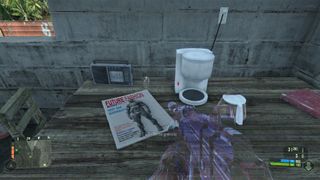
On the next page: the disappointments of Crysis 2 and 3.
PC Gamer is the global authority on PC games—starting in 1993 with the magazine, and then in 2010 with this website you're currently reading. We have writers across the US, Canada, UK and Australia, who you can read about here.

'Destiny has a long history of reinventing itself in response to feedback': Assistant director teases a Metroidvania-inspired future, talks weapon crafting and vault space, but fails to address the shocking number of bugs

Ballistic, Fortnite's new tactical FPS mode, is a deeply unserious Counter-Strike clone that's going to be huge anyway
Most Popular


